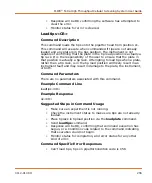
FLIPR
®
Tetra High Throughput Cellular Screening System User Guide
0112-0109 H
243
Transfer Fluid Processes
In general, settings for transferring fluids in remote control are the
same as in manual mode—with three exceptions. These are in
aspiration height over multiple plates, and the
Pause In Well
edit box.
Aspiration Height over Multiple Plates
When running in remote mode, a user may wish to use a common
addition source plate over a series of plates. The protocol(s) for this
may be done in a couple of ways. The simplest way to do this is to
create a single protocol which aspirates from the lowest allowed point
in the source well. When doing this, the user will have to determine the
maximum amount of liquid in the well so that the liquid displaced
during insertion of the tip into the well is not pushed out of the well.
This will limit the amount of liquid that can be used in the source well.
Alternatively, the user may choose to create a series of protocols at
successively lower aspiration start levels.
To provide an example of this situation, consider a user using a 384
well plate with a 250
μ
L well. This source plate is used to add a
common agonist to all wells. In the assay, 20
μ
L of this agonist is
added. The user would like to leave the plate in the instrument for a
series of plates before replacing it. The FLIPR
®
Tetra System a
instrument will allow protocols which begin aspiration as low as 8
μ
L for
this plate. Inserting a 384 well tip all the way to the bottom of this plate
will displace 50
μ
L of liquid.
In the simple method described above, the user should not start with
more than 190-200
μ
L of liquid in the plate because any more than this
may spill liquid when the tip is fully inserted. The single protocol would
begin aspiration at 8
μ
L height. They could then run this assay 9 times
before replacing the plate; leaving 10–20
μ
L of liquid in the wells after
the source plate is removed.
In the more complex implementation, the user may wish to fill the wells
to 230–240
μ
L. They would then set up an assay that would start
aspiration at ~240
μ
L in height, a second assay to start at ~220
μ
L, a
third to start at ~200
μ
L. The user could continue to create separate
assays at different heights or use the third assay for the remaining
plates. In this case, 11 plates can be run before the plates need to be
changed.
The simple method is simpler to setup and run. The more complex
method allows source plates to be switched less often. It also decreases
the proportion of wasted common reagents. Finally, it may decrease
carryover of compounds sticking to the outside of the tips, especially if
the protocols are created to retrieve liquid from progressively lower
heights all the way through the well height.
Содержание FLIPR Tetra
Страница 1: ...FLIPR Tetra High Throughput Cellular Screening System User Guide 0112 0109 H December 2011...
Страница 12: ...Contents 12 0112 0109 H...
Страница 16: ...System Overview 16 0112 0109 H...
Страница 40: ...System Hardware Features 40 0112 0109 H...
Страница 148: ...Exchanging Hardware 148 0112 0109 H...
Страница 156: ...Calibration and Signal Test 156 0112 0109 H...
Страница 196: ...Running an Experiment 196 0112 0109 H...
Страница 232: ...Robotic Integration 232 0112 0109 H The following drawings illustrate these requirements...
Страница 282: ...Data Processing Algorithms 282 0112 0109 H...
Страница 294: ...Consumables and Accessories 294 0112 0109 H...
Страница 298: ...Using AquaMax Sterilant 298 0112 0109 H...
Страница 302: ...Electromagnetic Compatibility EMC 302 0112 0109 H...
















































